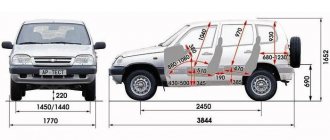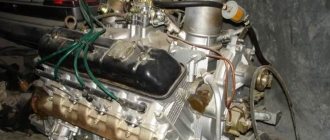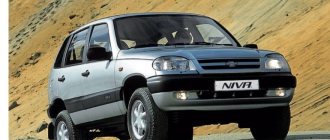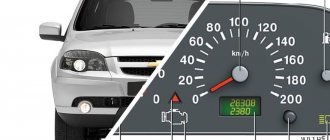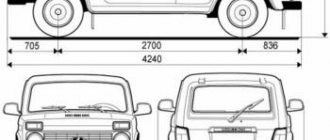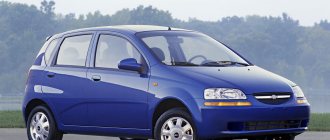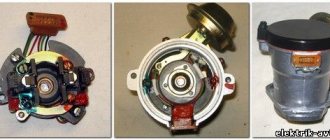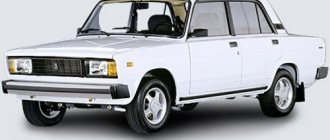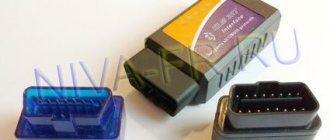Cars of the Chevrolet Niva model received the VAZ-2123 engine, which is quite powerful for this type of car, the main design features of which are a 4-cylinder vertical mechanism. The Chevrolet Niva engine has a built-in fuel injection control system and also complies with European Euro 2 standards for toxic emissions.
Comparing the new modification of the VAZ-2123 with previous analogues, one immediately notices one of the main advantages for the motorist - reduced noise level. This result was achieved thanks to the use of hydraulic chain tensioners, as well as a single-row chain device.
The reason for the reduced noise production is the presence of a hydraulic support for the valves. This engine has one more difference from previous models of this engine - the ability to install knock sensors on the cylinder blocks, which is provided by the bosses.
Design
It must be admitted that, structurally, the Niva Chevrolet engine is already outdated, which is not surprising, since it has been produced since 1994, and its development took place back in the 80s.
Its volume is 1.7 liters. The 4-cylinder block is made of cast iron, and on top there is an 8-valve head with 1 overhead camshaft. Timing chain drive. It uses a closed liquid cooling system with forced circulation. Distributed injection.
It is worth noting that there is a chain in the timing drive with a hydraulic tensioner, so the chain itself does not need to be tightened. In addition, there are hydraulic compensators, which eliminates the need for the owner to adjust the valves.
On the other hand, the implementation of all this in terms of quality is not up to par, and therefore some car owners equip the car with adjusting bolts and a mechanical tensioner.
Design features of the VAZ-2123 engine
The camshaft mechanism in the VAZ-2123 has not undergone any significant changes compared to previous models. It still has a single-row bush-roller chain, which is why all the sprockets in the engine structure have a single-row structure. Thus, the designers of this model have improved the operation of the oil transfer pump. You can read about the oil change itself here: Niva Chevrolet oil change.
Otherwise, all components remain the same and do not differ from previous models, such as 21214. This can be judged based on the installation of a spring-hydraulic system, which has been used in VAZ mechanisms for many years.
The water pump as well as the generator are driven by interaction with a pulley mounted on the crankshaft and driving the above-mentioned devices using a serpentine belt.
The standard belt used in the Chevy Niva engine is called “GATES” and serial number 58436 5РК1888.
Its characteristics:
- standard belt length – 188.8 cm;
- belt width – 1.7 cm;
- This belt has only 5 wedges.
One of the most noticeable changes in the new engine includes a redesigned engine compartment and a redesigned axle beam. The change in shape occurred due to a design feature - the lack of fastening of the front axle gearbox directly to the engine.
Therefore, this Niva sample is incompatible with engine parts and fasteners from earlier cars from this manufacturer.
Air intake system on VAZ-2123
The new Chevrolet Niva car has a completely new air intake system. The main difference is a significant increase in the volume of the air filter, which can be seen in the significantly larger body.
Elements such as the receiver, intake pipes and the pipe, replaced with a throttle version, were also structurally changed.
The electronic component of the car has also undergone changes. The main control of the motor is carried out thanks to the BOSCH controller, sample MP 7.9.7. In some individual copies, the “January” 7.2 system was also installed.
This not only affects the user-friendly interface, but also allows you to control fuel consumption due to an improved injection control system, which has a pair-parallel design. Thus, this machine has the ability to comply with Euro-2 standards.
To reduce the emission of harmful substances from a car, you can install a phased gasoline injection system, which will help raise the safety bar to the Euro-3 level and at the same time optimize the use of fuel due to its more accurate supply.
Other changes related to the operation of the Chevrolet Niva engine include:
- Fuel rail using a SIEMENS type injector;
- The ignition module has remained the same since the days of the VAZ-2112;
- The generator installed on the Chevrolet Niva has serial number 9402.3701-01. The designers chose the top location for it;
- For ignition, the car uses a starter model 5722.3708. Its main feature is the presence of a planetary gearbox. The maximum possible power is 1.55 kV;
- A plastic casing was installed to protect the motor.
Characteristics
The technical characteristics of the Niva Chevrolet engine are presented in the table.
| Model | VAZ 2123 |
| Material | Cast iron |
| Volume | 1,690 cm³ |
| Design | Inline |
| Power | 80 l. With. at 5,200 rpm |
| Torque | 125 Nm at 3,000 rpm |
| Number of cylinders | 4 |
| Number of valves | 8 |
| Supply system | Injector |
| Piston stroke | 80 mm |
| Cylinder diameter | 82 mm |
| Compression ratio | 9.4 units |
Fuel consumption is stated as follows.
| City | 11.5 l |
| Route | 8.3 l |
| Mixed cycle | 10.5 l |
But in practice, the appetite of an SUV is noticeably higher.
Which modification is better
It is impossible to say unequivocally which engine is more reliable and better. A lot depends on how you use the car. For urban conditions, the Z18XE is better suited; it is more effective on asphalt. The VAZ-2123 has lower revs, which is very good off-road.
If we take reliability into account, both cars break down. But the Z18XE has much fewer minor faults that ruin the lives of car enthusiasts. At the same time, the VAZ-2123 is well known for minor problems with leaks, sensor failures and other shortcomings.
Source
Malfunctions
It is worth noting typical Chevrolet Niva engine failures.
Knock
In cars that were produced before 2009, there is a knocking sound from hydraulic compensators, and this began to appear already at 60,000 km. In 2009, the problem was partially solved, and the service life of the hydraulic compensators increased to 100,000 km.
Flow
One of the most pressing problems of the power unit. As a rule, oil leaks from under the valve cover, and the rear crankshaft oil seal also leaks.
timing belt
The presence of a hydraulic tensioner in the engine design can lead to problems, since its reliability is not at its best. The most vulnerable component is the check valve and the aluminum oil supply pipe.
Owners note that they have to be changed after 50,000 km. It all starts with noise, and if you let the situation take its course, it can end with a chain jump.
Troit
The ignition “runs” for about 100,000 km, and in the event of a breakdown, the Niva Chevrolet engine begins to stall.
Stalls
It's all due to the throttle sensor, which sometimes fails after 100,000 km. In this case, the engine stalls after starting.
As for the remaining components, the idle speed control, pump, oil pump and some other units are at risk. There are cases of burnout of the head gasket. Sometimes the exhaust manifold mounting bracket falls apart.
Finalization
Some car owners, in order to improve technical characteristics and increase power, tune the Chevrolet Niva engine. But before resorting to this procedure, you need to think carefully about everything, this is due to the fact that it will not be possible to achieve any additional results.
There are several ways to slightly improve the performance of the power unit:
- Increasing the piston stroke from 1.7 to 1.9 liters. In this case, boring is performed and the internal diameter of the liners is increased, after which new pistons and rings are selected. A crankshaft with a shortened connecting rod and elongated arms is installed. In addition, the cylinder head is modified, the intake and exhaust ports are bored, and the valve is replaced with a part of a larger diameter, at the same time the valve seats are bored and replaced with new ones.
- The old carburetor is replaced with a new one and at the same time the standard connecting rods are replaced with lighter ones.
- Chip tuning. The old firmware is being replaced with an improved one.
All these modifications make sense only when traction is improved along with them, since this is the main feature of this type of car. The most important thing is that all modifications to the engine are carried out by an experienced person who knows his job, otherwise all the work done will lead to problems that will lead to breakdown of the power unit.
Replacement
Even if you take care of the engine and change the oil and filters on time, this does not guarantee the absence of breakdowns. As for purchasing another engine for a Niva Chevrolet, a new one at a dealership costs about 80,000 rubles. Naturally, if you bought a used SUV, such expenses seem excessive.
Regarding used power units, you can find many options in the range of 20,000 – 30,000 rubles. But there are many questions about the condition of such motors.
As you can see, the Niva Chevrolet engine has many weak points. However, there is no alternative to it, and therefore SUV owners have to put up with the situation.
How to change the oil in a Chevrolet Niva engine with your own hands
According to the maintenance regulations for this power unit, the oil should be changed after a travel distance of 15,000 kilometers. When operating the machine in difficult conditions, the time period is reduced to 7,500 km.
Measures to replace the lubricant are carried out with the engine turned off, a few minutes after the trip. The car must be located on a special elevated platform - an overpass.
Procedure:
- clean the drain plug located at the bottom of the oil pan;
- place a container to collect used lubricant;
- unscrew the plug;
- wait 10 - 15 minutes until the hot oil drains;
- dismantle the old one and install a new oil filter;
- clean the plug and screw it into its original place;
- pour a portion of new oil (3.5 - 3.7 liters) through the filler neck;
- wait 10 minutes and check the level using the oil dipstick (at this stage it should be at its maximum value);
- start the engine;
- check for oil leaks in the area of the filter and drain plug;
- turn off the engine;
- re-check the amount of lubricant (now the level between the MAX and MIN marks is considered normal);
- If necessary, add the missing oil.
Pros and cons of the regular Niva compared to the Chevy Niva
Let us highlight the characteristic features relating to both the 21st Niva and subsequent models VAZ-21213 and VAZ-21214. We will not consider the Long Niva (VAZ-2131), pickup truck (VAZ-2329) and other modifications. So, let's start with the undeniable advantages of the regular Niva compared to the Shevik:
- Patency. Due to the short wheelbase, the 21st model has better geometric cross-country ability.
- Price . In the same condition, a regular Niva will be 1.5-2 times cheaper than a Shevik.
- Availability and low cost of spare parts. Especially for body parts.
- "Psychological passability". An ordinary Niva is not so scary to be scratched or slightly dented, unlike a Chevrolet.
- The best predisposition for off-road tuning.
Now let's list the disadvantages of the 21st Niva compared to the Chevrolet Niva:
- Low level of comfort. Noise, vibration, lack of power steering (on old Nivas), uncomfortable driving position.
- Outdated design. Although this is a controversial point, because the design of an ordinary Niva is recognizable all over the world, which cannot be said about the Shniva.
- Poor aerodynamics.
- Poor handling on the highway.
- Cramped interior. This includes an uncomfortable seating position in the back row and a small trunk.
Everything is clear with the advantages and disadvantages of the regular Niva compared to the Shevik. Let's move on to the Chevrolet Niva.
Let us list the main advantages of the Chevrolet Niva:
- Modern and quite successful design.
- Passive safety. Although its level is unacceptably low, it is still slightly higher than that of a regular Niva. Chevy cars of recent years are preferable in terms of safety.
- Relatively high level of driving comfort. Less vibration, less noise, comfortable driving position, power steering.
- Spacious salon. This also includes a comfortable back row, seating and a relatively spacious trunk.
- Good aerodynamics.
- More expensive than a regular Niva, both in purchase and in maintenance and repair.
- Poor cross-country ability due to the extended base and lower bumpers.
- An abundance of plastic, especially on new Sheviks. A controversial point, because plastic protects the body from minor damage (scratches, chips).
- Weak engine. The dynamics of Shevik are worse than those of a regular Niva.
- More mass. On marshy soils this is a minus, but in other cases it can be a plus (shallow mud, loose snow).
It is also worth paying attention to one more point - body rigidity. It seems that the three-door car should have it higher, but the Shevik has thicker side members, so not everything is so simple
Service
In order for the engine to last as long as possible, it must be properly maintained. The basic rule is timely oil changes. The manufacturer recommends doing it every 15 thousand kilometers. In this case, every second replacement must be combined with washing. These rules apply to both types of engines.
Only synthetic oil should be used. There are no special restrictions on the type; any will do:
- 0W-30;
- 0W-40;
- 5W-30;
- 5W-40;
- 5W-50;
- 10W-40;
- 15W-40.
The required volume for a complete replacement in the Z18XE is 4.5 liters, for the VAZ-2121 3.75 liters is enough.
The advantage of the VAZ-2123 is that a timing chain is used to drive it. It has a higher resource and therefore changes much less frequently. The manufacturer does not give clear recommendations for replacing it, but according to the experience of the owners, it is best to check or replace it at 150 thousand kilometers. Problems with the chain can be identified by increased noise at high speeds - this indicates a failure of the tensioner and stretching.
It is best to replace the belt on the Z18XE after 45-50 thousand kilometers, otherwise the risk of breakage increases. The engine is 16-valve, so most likely they will bend and require expensive repairs.
Computer diagnostics
The most complete diagnosis is possible with a computer or laptop. In order to use this method, you must purchase an adapter. This adapter performs two functions at once. It is an adapter from a K-line port to a USB port or to a COM port. It also acts as a decoder, which allows you to transmit signals from the ECU to the PC. You will also need to install the appropriate software on your laptop. There are a lot of free versions on the Internet. There are universal programs, as well as programs written for a specific car. After connecting to the computer, you will need to turn on the ignition and launch the program. The connection will happen automatically.
The interface of the computer program is very convenient and allows even an inexperienced user to navigate intuitively. All functionality can be divided into several sections. These are parameters, errors and settings. If the first two sections are informational, then using the third section you can control the vehicle systems.
Motor maintainability
The Chevrolet Niva engine will last a long time if you take care of it, use high-quality consumables, and good fuel. However, even the most reliable mechanism can sometimes fail, in which case engine repair will be required. We will not dwell on how to carry out an internal combustion engine overhaul ourselves; this requires solid experience, the availability of tools, equipment, and spare parts.
Entrust this matter to specialists, it will be more reliable. A properly repaired VAZ 2123 engine will allow you to operate the car for a long time. Major repairs and their scope are not cheap operations, so it is important to operate the vehicle correctly.
Let's look at what could be a “minor” cause of internal combustion engine failures that can be eliminated independently. These may be the following factors:
- Reducing engine power;
- Troubleshooting during operation of the power unit;
- Poor starting in any weather;
- The motor overheats;
- Floating engine speed.
It cannot be said that these are all signs of engine failure; there may be others, which not every driver can eliminate on their own. Power can drop for several reasons:
- Poor quality of gasoline used;
- Electronic control unit problems;
- Interruptions in the operation of engine sensors;
- Troubles the engine;
- Increased wear of piston group parts.
There may be other reasons, which can be determined using special equipment available in repair shops. Troubling of a running engine can be caused by interruptions in the operation of the injectors. Such a malfunction can be eliminated by cleaning them. A running engine increases gas mileage and loses power.
Starting the power unit also depends on the quality of the fuel mixture, engine compression, serviceability of the fuel supply system, ignition unit, serviceability of the starter, and battery charge. Overheating of the motor due to its operating conditions is almost impossible. The cooling system can have two options for cooling the radiator, with one or two fans.
Most often, overheating occurs when the thermostat is stuck or leaks in the cooling system. The speed may fluctuate due to failures of engine sensors, problems with the ECU, or malfunctions of the throttle valve. Such problems can be identified and then eliminated after computer diagnostics.
Advice! Unskilled intervention in the internal combustion engine of your car can cause serious damage not only to your wallet, but also to the engine.
Chip tuning
The serial production power unit shows excellent performance data, significantly different from the usual ones. An engine that has undergone major changes and has a large combustion chamber volume, a reduced connecting rod mass, a reduced weight crankshaft, a modernized camshaft and a split gear of the timing drive device especially requires a change in the parameters of the electrical unit with which the control is carried out:
Drivers who have been using this car for a long time believe that the control electronics do not tolerate interference, and all efforts to reflash the program in order to modernize it remain in vain. This is actually true, but this feature applies only to cars of the first serial production. Today it is possible to calibrate a memory device. For a regular engine, chip tuning will increase power and torque by ten to fifteen percent. For a turbocharged engine, the increase will be at least a third of the original figure.
